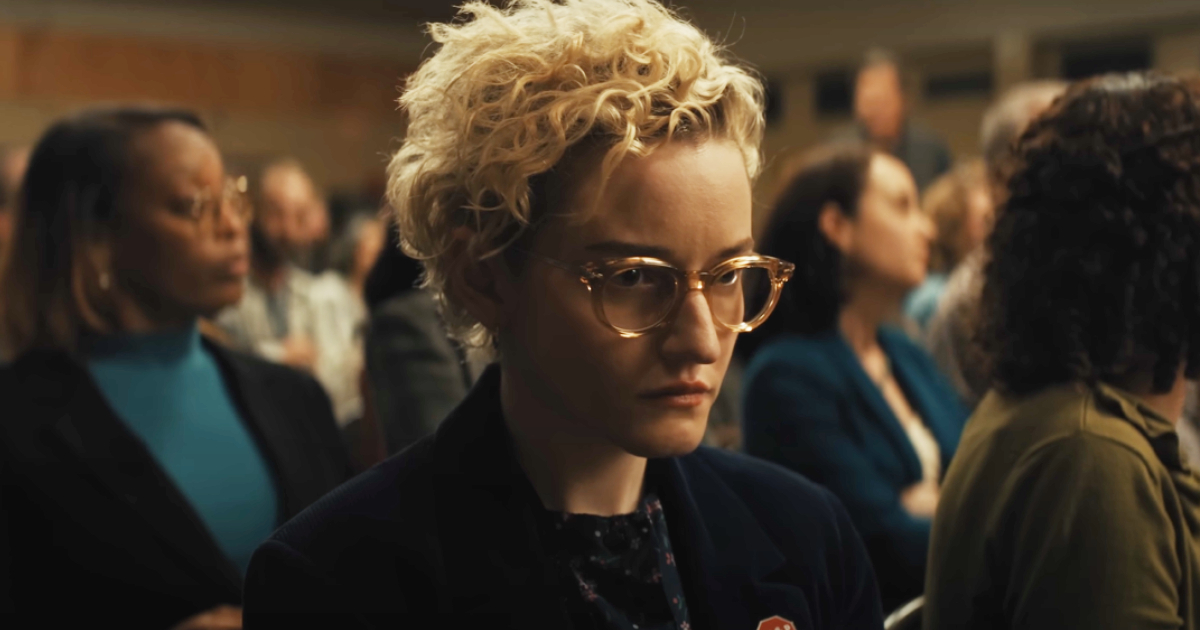
Zach Cregger’s horror thriller Weapons turned into a surprise crowd-puller and critical favorite. All thanks to its unsettling blend of mystery, gore, and psychological dread. Fronted by Julia Garner, Josh Brolin, and Amy Madigan, the movie dives into a small town terrorized after 17 children inexplicably abandon their homes one night.
They later vanish into the woods as if under a spell. The culprit, a parasitic evil with an appetite for human life, eventually faces destruction. But the chaos it leaves behind is laced with unanswered puzzles. And like any good genre hit, those loose ends are the ones people can’t stop talking about.
1. What’s Up With That Floating Gun?
Dream sequences in horror films usually scream “symbolism,” and Weapons delivered one that viewers haven’t stopped dissecting. In a particularly eerie moment, Archer Graff (Josh Brolin) nods off in his missing son’s bed and dreams of a hovering assault rifle hanging above the Lilly house, the place where the missing children are kept. The weapon ticks out the exact time of their departure, which is 2:17 a.m., and ever since, fans have been drawing connections. Many argue it’s tied to the film’s title and even to real-world violence, especially considering how grief, anger, and the survival of one bullied child dominate the town’s storyline.
Trending
But if you ask Cregger, he’ll be the first to tell you there’s no single explanation. Talking to Variety, he admitted, “It’s a very important moment for me in this movie, and to be frank with you, I think what I love about it so much is that I don’t understand it. I have a few different ideas of what it might be there for, but I don’t have the right answer. I like the idea that everyone is probably going to have their own kind of interaction or their own relationship with that scene, whether they don’t give a shit about it and it’s boring, or whether they think it’s some sort of political statement, or whether they think it’s just cool.”
So while the floating gun may look like a clear metaphor, Zach Cregger insists it isn’t meant as a manifesto. The sequence exists more as a provocation, the kind of surreal imagery that pushes an audience into debate without handing them a conclusion.
just got out of weapons but I keep thinking to myself, what was the purpose of the floating gun above the dads house and it showing 217… like that was so random and not elaborated on at all #WeaponsMovie #Weapons
— ethan m (@1057Ethan) August 10, 2025
2. Aunt Gladys — Witch, Parasite, Or Something Else?
If anyone walked out of the theater unsure about who or what Aunt Gladys really was, that’s exactly how Cregger wanted it. Played with unnerving calm by Amy Madigan, Gladys is introduced as a relative, but quickly unmasked as the story’s true villain. Her powers don’t come from a normal source; she thrives by siphoning the life force of others. Gladys stretches her existence far beyond any ordinary lifespan.
Hints about her past drop throughout the movie. At one point, Gladys refers to “consumption,” an outdated term for tuberculosis, suggesting she has lived since at least the late 1800s. Early drafts reportedly gave her an entire backstory chapter, but Cregger scrapped it in favor of ambiguity. The result is a character who feels ancient, almost mythological, without ever being explained outright.
Her presence ties into the central theme of parasitism, like how evil feeds, grows, and refuses to die unless completely burned out. That makes Gladys less of a stock witch and more of an embodiment of generational darkness, the kind of antagonist who lingers in folklore long after her last scene fades.
I can’t stop thinking about Aunt Gladys character design pic.twitter.com/aEnziiwRoq
— ᧒ꫀ᥅ᛕ ᭙ꪖꂟ (@dannooze) August 11, 2025
3. The Strange Case Of The Bell’s Symbols
No horror movie is complete without one creepy object, and in Weapons, that item is Gladys’ bell. Covered in cryptic markings, the bell becomes her most lethal tool. It is not just an accessory, but the key to unleashing possession. Its engravings include an inverted triangle and the number six, both steeped in occult history.
In witchcraft, the triangle (especially inverted) is often tied to the Crone goddess and feminine mysticism. The number six, on its own, is already linked with the idea of devilry, and when repeated (666), becomes synonymous with ultimate evil. Put together, the carvings on the bell read less like random designs and more like a label of ownership. This was Gladys’ weapon, a ritual device meant to seal curses once she brewed them.
The details don’t stop there. Viewers who stayed through the credits spotted the triangle flipped upright in the closing sequence. That small adjustment may hint at something alchemical, a nod to potions and transformations. Paired with the blackthorn branches she uses to control victims, the bell’s role feels less ornamental and more central to her craft.
In the end, the exact function of the symbols is never spelled out, but that’s the point. Like much of Weapons, the bell leaves audiences piecing together lore from scraps, a mystery preserved by design. One that may be explored further if the rumored prequel plans come to fruition.
WEAPONS SPOILERS-
–
Something I haven’t seen anyone discuss is the fact that the triangle in the title screen and the bell Aunt Gladys rings is the alchemist symbol for “fire”, but in a more metaphorical sense. Gladys is LITERALLY “firing” the kids as weapons.— 𝐢𝐧𝐤➸saw 𝔤𝔥𝔬𝔰𝔱 (@earlgrayteabags) August 17, 2025
You can check out the trailer of Weapons here:
For more such stories, check out Hollywood News
Follow Us: Facebook | Instagram | Twitter | YouTube | Google News



 Follow Us
Follow Us











